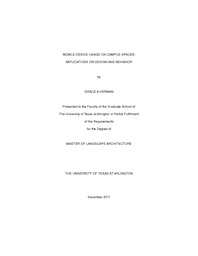
ATTENTION: The works hosted here are being migrated to a new repository that will consolidate resources, improve discoverability, and better show UTA's research impact on the global community. We will update authors as the migration progresses. Please see MavMatrix for more information.
Show simple item record
| dc.contributor.author | Herman, Grace A. | en_US |
| dc.date.accessioned | 2012-04-11T20:56:18Z | |
| dc.date.available | 2012-04-11T20:56:18Z | |
| dc.date.issued | 2012-04-11 | |
| dc.date.submitted | January 2011 | en_US |
| dc.identifier.other | DISS-11468 | en_US |
| dc.identifier.uri | http://hdl.handle.net/10106/9578 | |
| dc.description.abstract | This study explores the relationship between place, behavior, and technology in order to identify how users interact with the physical features of public space while interacting with mobile technology. The introduction of digital media has altered the way in which individuals engage socially within places (Gergen 2002; Hampton 2009; Humphreys 2005; Kleinman 2004; Louv 2011; Paulos 2003; Small 2008). The private nature of mobile device use modifies the social atmosphere in public spaces (Caballero-Munoz 2006; Eriksson 2007; Humphreys 2005; Paulos 2003; Srivastava 2005). For example, mobile phone users often block out others within their vicinity both physically and mentally in order to tend to the social networks with their phones (Humphreys 2005). This research examines behaviors of people using mobile devices. Social norms are documented in the literature review as well as the collected data (Goffman 1963; Whyte 1980). Public places provide opportunities for economic, social, and cultural exchanges that promote community because they supply a shared space (Carmona 2003; Eriksson 2007; Hampton 2009; Whyte 1980). Behavior in these public spaces is documented by Goffman (1963) and Whyte (1980); however, social interaction is evolving with communication technologies (Ashbrook 2001; Caballero-Munoz 2006; Glaeser 2011; Louv 2011; Small 2008; Walsh 2008). For instance, mobile devices challenge traditional concepts of space and time (Caballero-Munoz 2006; Paulos 2003; Rettie 2005). Also, the growing use of mobile technology encourages private interactions within public places (Caballero-Munoz 2006; Eriksson 2007; Humphreys 2005; Paulos 2003; Srivastava 2005). This influences the way in which users conceptualize their identity, engage with each other, and interact with the physical world (Caballero-Munoz 2006; Hampton 2009; Rettie 2005; Srivastava 2005). Studies suggest that interacting with physical places can be used to battle the negative effects of technology (Louv 2011). Video recordings were used in this study to capture users coping with mobile device usage in a public places. The camera recorded at two plazas - the Central Library Plaza and the Maverick Activity Center Plaza -- on The University of Texas at Arlington campus at a variety of times. Field notes and observations were taken and coded in order to identify potential themes (Corbin and Strauss 1990). These data were then compared to secondary data on behavior in public spaces extracted from the literature review. Maps that represent device usage and mobility at fifteen minute intervals were then created in order to spatially examine the data. The earlier identified themes were then used to analyze data on each mapped frame. This data was encoded to study how device usage influences use of public space.In the course of the passive observations it was found that mobile device usage was lower in more complex environments. In both the observed plazas on the University of Texas at Arlington campus, the majority of the device users were engaging with a mobile device in their hands as opposed to talking with it to their ear. The presence of organized events was positively correlated with reduced device usage. In addition, device usage was higher among participants in unfocused interactions, a behavior type identified by Goffman (1963). Device users were also more often observed in motion than sitting or standing. Seating at the Maverick Activities Center was more likely to be occupied by device users while sitters at the Central Library were more likely to be without a device. Finally, sun was found to influence the location of users with a device in their hand. Design implications were identified to respond to elements like social interactions, mobility, event participation, seating, sun, temporary installments, time of use, and zones of activity. This study concludes that places are not devolving but evolving with the introduction of mobile devices into the public sphere. Places must become more competitive to attract users who are increasingly able to choose their location due to the mobility of communication technology. Universities will likely reconsider their public spaces in order create more comfortable and fulfilling places that respond to the increasing presence of mobile device usage. | en_US |
| dc.description.sponsorship | Taylor, Pat D. | en_US |
| dc.language.iso | en | en_US |
| dc.publisher | Landscape Architecture | en_US |
| dc.title | Mobile Device Usage On Campus Spaces: Implications On Design And Behavior | en_US |
| dc.type | M.L.A. | en_US |
| dc.contributor.committeeChair | Taylor, Pat D. | en_US |
| dc.degree.department | Landscape Architecture | en_US |
| dc.degree.discipline | Landscape Architecture | en_US |
| dc.degree.grantor | University of Texas at Arlington | en_US |
| dc.degree.level | masters | en_US |
| dc.degree.name | M.L.A. | en_US |
Files in this item
- Name:
- Herman_uta_2502M_11468.pdf
- Size:
- 26.29Mb
- Format:
- PDF
This item appears in the following Collection(s)
Show simple item record


